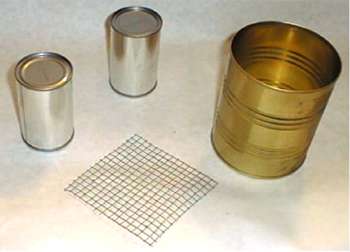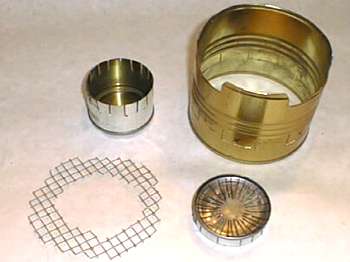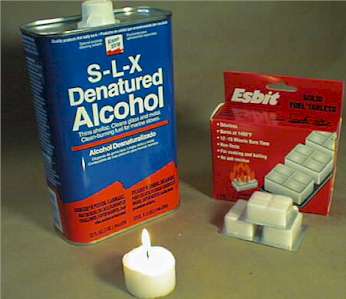The Fallingwater Multi-Fuel Stove!
 This stove is another in the line of KISS Stoves that are designed to simplify your backpacking experience. This stove is another in the line of KISS Stoves that are designed to simplify your backpacking experience.
In recent years, the number of hikers looking for alternatives to the traditional gas stoves has increased. Many of these hikers have adopted the Esbit solid fuel stoves for their simplicity and ease of shipping fuel through the mail. Another group is adopting the use of homemade alcohol stoves.
A while ago I'd made the decision to leave my old Whisperlight home on backpacking trips. Especially when I was going alone. I just got tired of the weight and waiting for it to fail. Granted I generally put off any differed maintenance until the night before the trip. And then its in a rush check to insure the stove would simply ignite.
I liked the Esbit fuel stove I carried. It's simple and easy to use. However, it lacks a good wind screen. In general I figured I could do better. Along came those homemade Alcohol stoves and my head was spinning again. Alcohol was much simpler to acquire along the trail and certainly considerably cheaper. At $.50 per meal or a dollar a day, the Esbit fuel could easily add up to serious money on a five month hike. Cost of running an alcohol stove comes in at around $.20 per day. Certainly a significant savings for someone as cheap as me.
After reviewing Roy Robinson's alcohol stove on a trip to Lake Tahoe, I immediately when home with the gears in my head spinning. Figuring I could do better, I spent several nights building the perfect stove. Upon lighting, it caved in on itself and flaming alcohol went running across a wooden board, heading straight for the counter. After dousing the whole mess with water, I tossed the stove up on a shelf as an experiment in futility. I pulled out my sewing machine thinking my design talents defiantly ran elsewhere.
All through several sewing projects, I couldn't get that damn stove out of my mind. Upon running out of material for sewing, I reluctantly returned to the stove. This time I wanted to make it simple and also support both Alcohol and solid fuel like Esbit.
The Fallingwater Multi-Fuel Stove is the second generation of the multi-fuel stove. This design incorporates the alcohol burner in the stove. In the first generation, the alcohol burner was a separate component. The top of the stove has been modified to better deflect the wind. The number of vents on the top has been reduced to two and they are both placed on one side of the stove. The alcohol burner has been modified and the efficiency has improved by 25%. This reduces boil time from a little over 10 minutes to 7.5 minutes.
Materials

- 1- 1 lb coffee can or a can that's at least 3.5" tall by 4" across.
- 1 - 4 inch square of quarter inch heavy wire mesh
- 2 - Tomato paste cans.
- A few inches of standard pink fiberglass house insulation. Check your attic. (Not shown)
Total cost for materials is free.
Tools
- Dremel Tool
- Hammer
- Wire Cutters
- Needle Nose Pliers
It maybe possible to use something else beside the Dremel tool. However, I've found it perfect for making clean cuts.
Construction
Main Stove
- Cut the can down to 3.25 inches in heigth.
- Cut a series of six 1 X .5 inch slots around one end of the can a 3/4 inch from the bottom and 1 inch apart.
- From the top, cutout two 2 X .5 inch sections. These cutouts should be on one side of the stove. The back half of the top is solid to deflect the wind.
- Cut a series of 1/8 inch deep slits into the top of the stove. Bend them over flat to create a smooth edge along the top of the stove.
Alcohol Burner Bottom
- Cut the top of one of the tomato paste cans down to 1.25 inches.
- Cut a series of .5 inch wide slits a half inch down from the top of the can.
Alcohol Burner Top
- Cut the second tomato paste can down to .5 inches high.
- With a hammer, gently pound the top of the can into a shallow concave bowel.
- On the side of the can, cut a series of .5 inch wide slits all the way around.
- In the bowel of the burner, cut a series of slits radiating around the perimeter of the can about an eighth inch apart. Leave a .5 inch clear section in the center of the bowel.
Wire Grid
- Trim the 4x4 in wire mesh to 4 inch round.
- Cut a hole in the middle of the mesh the size of the alcohol burner.
Assembly
 First attach the bottom burner to the wire mesh. To do this, bend every other tab out 90 degrees. Insert the standing tabs into the wire mesh. When fully inserted, bend down the rest of the tabs. It should look like the photo on the left. First attach the bottom burner to the wire mesh. To do this, bend every other tab out 90 degrees. Insert the standing tabs into the wire mesh. When fully inserted, bend down the rest of the tabs. It should look like the photo on the left.
- Take a small wad of insulation and place it into the bowel. It should fill up the entire bowel but not be too compressed.
- Take the top of the alcohol burner and insert it into the bottom. Take your hammer and tap it in securely.
- In the stove body, fold up every other tab inward so that it's perpendicular to the body. Insert the alcohol/mesh into the bottom of the stove with the burner facing up. Then fold the remaining three tabs to hold the burner securely in place.
That's it! You've just built your own Fallingwater Multi-Fuel Stove. The whole thing weighs in at 2.3 ounces. All told, it'll take about two hours to construct.
Fuels
Solid / Esbit Fuels
Aside from Esbit fuel tabs, this stove should be able to burn any of the available solid fuel tabs such as Hexamine or Trioxane. These tabs lack the efficiency of Esbit and will require more fuel per meal.
In tests, an Esbit tab was able to bring 2 cups of 60 degree water to a boil in 6.5 minutes. There was enough tab left to burn for another 6 minutes.
Alcohol Fuel
There are numerous sources of alcohol available on the market. However, standard denatured alcohol seems to provide the greatest burn for the least amount of fuel.
In test on this stove burning alcohol, I was able to bring 2 cups of water to a boil on two tablespoons of fuel. It took about 7 minutes to raise the 60 degree water to the boiling point. Using the stove in the mountains with cold stream water will require a more fuel to boil the water. Two tablespoons of denatured alcohol burned between 10 and 11 minutes in duration.
Under normal operation, the alcohol flame burns blue and may be difficult to see.
Stove Operation
This should be obvious by now. Simply add the fuel and light a match. There are no moving parts to adjust. In the case of using alcohol, you'll need to wait until the fuel has consumed itself. With Esbit fuel tabs, you can blow them out and store them away until for later use.
Simmering
No, you haven't read this wrong. I mentioned simmering because this stove will allow you to simmer your foods. To do so simply blow out or finish burning your primary fuel. Wait a few moments for the stove to cool then light a small short candle and place it on the mesh. The candle will provide sufficient heat to do basic simmering. Since the candle will last for sometime, you'll be able to use it for multiple meals.
Notes
This stove is designed to provide a degree of safety. However, no stove is safe if left unattended.
There is a large gap between the bottom of the wire mesh and the ground. This gap minimizes the heat transferred downward. In one test on the stove, I shredded a soft paper towel - to simulate ground litter - and performed a full burn of the alcohol stove. At the end, the paper towel wasn't even warm let alone scorched. So if you have a habit of cooking your meals on shelter floors, you won't have to worry about leaving those ugly burn marks.
Caution: This stove is not designed to burn highly volatile fuels like gas, diesel, kerosene or camp stove fuel. The fuels are far too volatile to be burned in an open container.
Enjoy!
Ron Moak
Copyright (C) 1999,2000 Ron Moak |
Komplete Individual Simple Stoves - KISS
Based on the philosophy of the "Keep It Simple Stupid!", KISS stoves are designed to simply the backpackers life. Leaving them more time to enjoy the experience and less time to worrying if their stove fire up. Or worse yet, become a fireball torching everything is sight.
In recent years, the trend for many hikers is to reduce their pack loads in order to better enjoy their backcountry adventures. Tents are being replaced with tarps and heavy packs replaced by lightweight ones. It's only natural to start looking at the most complex piece of equipment carried by backpackers.
Backpacking stoves are a marvel of modern engineering. Complex beast with all sorts of bells and whistles, they put out an amazing amount of heat for such a small package. For most of us they are way over kill for our normal needs, and when they go wrong. Well they can really go wrong. Lucky is the hiker never has one breakdown at an inconvenient time.
On the other hand, KISS stoves are designed from the ground up to be maintenance and worry free. Just add fuel and light.
Advantages of KISS Stoves
Lightweight - KISS stoves uses fuel that doesn't require complex pumps, high pressure, multiple gaskets and valves. Unencumbered with all of this added paraphernalia these stoves can be very light. Often weighing no more than a few ounces, compared to a pound or more for the liquid fuel stoves.
Simplicity - Add the fuel and light a match, is generally all that's required to start these stoves. No pumping, priming or pre-lighting is required. These stoves can be working away long before traditional stoves are even assembled, let alone up and running.
Quite - Gas stoves often sound like your own personal jet engine. Once lit, they take off like a screaming banshee. Not exactly the sound one wants to hear when enjoying the sounds of the forest. Homemade stoves are quite. In fact generally they can't even be heard.
No Maintenance - Pack along your traditional stove and you better pack the repair kit also. By the way, you may need a small pair of pliers or a little oil to take your stove apart for maintenance. All of this maybe fine done on the kitchen table, but it can be downright irritating, field stripping a stove to make repairs in the cold and dark. With no moving or complex parts, these stoves have nothing to breakdown.
Safety - Ever had a stove turn into a ball of fire while cooking. High pressure gas stoves can easily do so if a gasket fails. Even under normal operation, gas stoves become little fireballs if too much fuel is used during the priming process. Without the need to keep the fuel under high pressure, non-traditional stoves pose a significantly reduced danger of explosion or burning all your valuable gear.
Low Cost - KISS Stoves can be made for pennies compared to the high cost of traditional stoves. Made from recycled cans and other cheap items, these stoves can be made cheaply and quickly.
Disadvantages of KISS Stoves
Even the best stoves have problems or circumstances where they don't perform well.
Reduced Output - Non-Traditional stoves lack the heat output to boil large quantities of water or regulate their output. If you're planning on cooking large meals for a number of people, a more traditional stove will be more appropriate. However, your traveling solo, cooking simple meals that require minimal cooking, the Non-traditional stove maybe your best choice.
Other Homemade KISS Stoves available online.
Commercial KISS Stoves
|
Copyright (C) 1999,2000 Ron Moak |
|